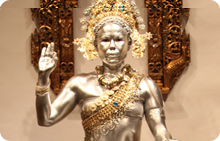Since the Company’s inception in 1990, our environment has played a key role in the creation of IONA’s shows and characters. Emphasizing effects of global warming, biodiversity, rainforest preservation, marine conservation, and animal rights are integral to IONA’s vision and has fueled dozens of dances over the years.
In Artistic Director Cheryl Flaharty’s solo work ‘The Forest, The Cage’ (1990), she portrays the Spirit of the Rain Forest, dancing amidst a stage set of colorful silk banners assimilating the trunks of great trees, who is caged after the forest’s destruction.
Created in an era of sovereignty, IONA’s ‘Hawaiian Myths & Legends’ (1995) was the first contemporary work based on Hawaiian mythology. The work draws its inspiration from the Polynesian environment that inspired the creation of the ancient gods and goddesses. Set to the music of Bolero, ‘You’re the One for Me’ depicts the often sultry battle between Kamapua’a, the Hawaiian Pig God in his green velvet suit - representing his mountainous domain against Pele, the Hawaiian Volcano Goddess. In the work’s ultra-violet finale Pele’s lava erupts and the dancers appear out of the darkness as fluorescent paint is poured onto their bodies.
IONA’s ‘Destiny’ (2002) uses the tree as an archetype for the feminine principle of holism against the patriarchal world view of separation. In 2006 Flaharty and her team created ‘Electric Blue’ after reading Jeffrey Rothfeder’s book Every Drop for Sale. Using water as a metaphor for the soul and a connecting force between world cultures, the production brought the dancers into the elements of the outdoor stage to perform excerpts of the work on local beaches.
IONA’s ‘The Living Earth’ (2009) revolves around a living altar of sacred statues designed to honor and raise awareness to the current state of the planet and human consciousness. The interactive show presents nine performance areas designed to educate the audience on the changes the planet is undergoing. One dancer wrapped in a white fur coat struggles with a block of ice; another sheds a large grey cloth as the skin of the dying elephant. The nine performances include interpretations of world peace, biodiversity, animal rights, Mother Nature, metamorphosis, nuclear disarmament, cultural and religious diversity, global warming, and environmental protection – all creating a theatrical dialogue of universal concerns.

IONA strives to create a theatrical dialogue of universal concerns.
DANCING FOR THE PLANET








